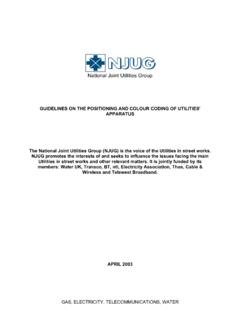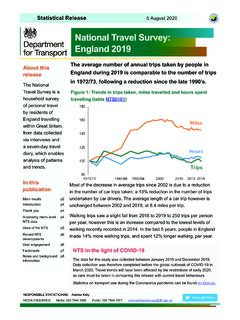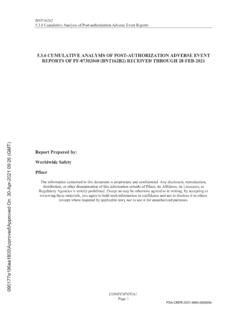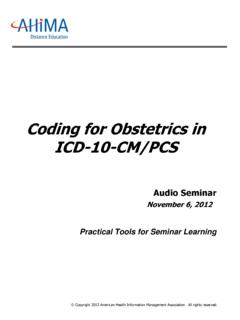Transcription of PISA 2012 Technical Report - OECD
1 PISA 2012. Technical Report P r ogr am m e f or Int er nat ional St udent As s es s m ent PISA 2012. Technical Report This work is published on the responsibility of the Secretary-General of the OECD. The opinions expressed and arguments employed herein do not necessarily reflect the official views of the Organisation or of the governments of its member countries. This document and any map included herein are without prejudice to the status of or sovereignty over any territory, to the delimitation of international frontiers and boundaries and to the name of any territory, city or area. Note by Turkey: The information in this document with reference to Cyprus relates to the southern part of the Island. There is no single authority representing both Turkish and Greek Cypriot people on the Island. Turkey recognises the Turkish Republic of Northern Cyprus (TRNC).
2 Until a lasting and equitable solution is found within the context of the United Nations, Turkey shall preserve its position concerning the Cyprus issue . Note by all the European Union Member States of the OECD and the European Union: The Republic of Cyprus is recognised by all members of the United Nations with the exception of Turkey. The information in this document relates to the area under the effective control of the Government of the Republic of Cyprus. The statistical data for Israel are supplied by and under the responsibility of the relevant Israeli authorities. The use of such data by the OECD is without prejudice to the status of the Golan Heights, East Jerusalem and Israeli settlements in the West Bank under the terms of international law. Photo credits: Flying Colours Ltd/Getty Images Jacobs Stock Photography/Kzenon khoa vu/Flickr/Getty Images Mel Curtis/Corbis Shutterstock/Kzenon Simon Jarratt/Corbis OECD 2014.
3 You can copy, download or print OECD content for your own use, and you can include excerpts from OECD publications, databases and multimedia products in your own documents, presentations, blogs, websites and teaching materials, provided that suitable acknowledgement of OECD as source and copyright owner is given. All requests for public or commercial use and translation rights should be submitted to Requests for permission to photocopy portions of this material for public or commercial use shall be addressed directly to the Copyright Clearance Center (CCC) at or the Centre fran ais d'exploitation du droit de copie (CFC) at Foreword The OECD Programme for International Student Assessment (PISA) surveys, which take place every three years, have been designed to collect information about 15-year-old students in participating countries.
4 PISA examines how well students are prepared to meet the challenges of the future, rather than how well they master particular curricula. The data collected during each PISA cycle are an extremely valuable source of information for researchers, policy makers, educators, parents and students. It is now recognised that the future economic and social well-being of countries is closely linked to the knowledge and skills of their populations. The internationally comparable information provided by PISA allows countries to assess how well their 15-year-old students are prepared for life in a larger context and to compare their relative strengths and weaknesses. PISA is methodologically highly complex, requiring intensive collaboration among many stakeholders. The successful implementation of PISA depends on the use, and sometimes further development, of state-of-the-art methodologies and technologies.
5 The PISA 2012 Technical Report describes those methodologies, along with other features that have enabled PISA to provide high quality data to support policy formation and review. The descriptions are provided at a level that will enable review and, potentially, replication of the implemented procedures and Technical solutions to problems. This Report contains a description of the theoretical underpinning of the complex techniques used to create the PISA 2012 database, which includes information on 510 000 students in 65 countries or economies. The database includes not only information on student performance in the main areas of assessment mathematics, reading, science, problem solving and financial literacy but also their responses to the Student Questionnaire that they completed as part of the assessment. Data from the principals of participating schools are also included.
6 The PISA 2012 database was used to generate information and to be the basis for analysis for the PISA 2012 initial Report , PISA 2012 Results (OECD, 2013 and 2014). The information in this Report complements the PISA Data Analysis Manuals (OECD, 2009), which give detailed accounts of how to carry out the analyses of the information in the database. The PISA surveys are guided by the governments of the participating countries on the basis of shared policy-driven interests. The PISA Governing Board, which decides on the assessment and reporting of results, is composed of representatives from each participating country and economy. The OECD recognises the creative work of Raymond Adams, of the Australian Council for Educational Research (ACER), who is project director of the PISA Consortium, and Ross Turner who acted as editor for this Report .
7 The team supporting them comprised Susan Bates, Alla Berezner, Jonas Bertling, Renee Chow, John Cresswell, Alexander Daraganov, Steve Dept, Andrea Ferrari, B atrice Halleux, Eckhard Klieme, Nora Kovarcikova, Sheila Krawchuk, Petra Lietz, Greg Macaskill, Juliette Mendelovits, Alla Routitsky, Keith Rust, Stephanie Templeton and Maurice Walker. Christian Monseur and Maciej Jakubowski provided Technical advice to review this Report . A full list of the contributors to the PISA project is included in Annex G of this Report . The editorial work at the OECD Secretariat was carried out by Josefa Palacios, Giannina Rech, Sophie Vayssettes and lisabeth Villoutreix. Lorna Bertrand Andreas Schleicher Chair of the PISA Governing Board Director for Education and Skills, OECD. PISA 2012 Technical Report OECD 2014 3. Table of Contents Reader's Guide 19.
8 Chapter 1 Programme for International Student Assessment: an 21. 23. Features of 24. Managing and implementing 25. Structure of this 26. Chapter 2 Test Design and Test 29. Test scope, design and 30. Paper-based assessment design: mathematics, reading, science, financial 30. Computer-based assessment design: problem solving, mathematics, 32. Domain definitions, and item design: The 2012 assessment 33. Test development centres .. 35. Scope, volume and 36. Development timeline and 37. Field 41. Main Survey preparation, implementation and 44. Main Survey item selection .. 44. Dispatch of Main Survey 45. Main Survey coder 45. Main Survey coder query 45. Review of Main Survey item 45. Released 45. Chapter 3 Context Questionnaire 47. 48. A sustainable framework for the PISA context 48. Cross-cultural comparability of measures in the context 51.
9 Anchoring 51. Topic Familiarity with Signal Detection 52. Situational Judgment 53. Forced 54. Transitioning the context questionnaires from paper administration to online administration 54. Update of the International Standard Classification of Occupations (ISCO) from its 1988 version to the 2008 55. The measurement of Opportunity to 56. Opportunity to Learn content .. 56. Opportunity to Learn teaching practices .. 57. Opportunity to Learn teaching 57. The rotation of the Student Context Questionnaire design and intended 58. PISA 2012 Technical Report OECD 2014 5. table of contents Chapter 4 Sample 65. Target population and overview of the sampling 66. Population coverage, and school and student participation rate 67. Coverage of the PISA international target 67. Accuracy and 68. School response 68. Student response 69.
10 Main Survey school 70. Definition of the national target 70. The sampling 70. 71. Assigning a measure of size to each 74. School sample 74. Special school sampling 76. Monitoring school 80. Student 84. Chapter 5 Translation and Verification of the Survey 89. Development of source 90. Double translation from two source 91. PISA translation and adaptation 92. Translation training 92. Testing languages and translation/adaptation 92. Testing 94. International verification of the national 94. Verification of paper-based test 95. Main Survey verification of paper-based test 97. Verification of the booklet 99. Verification of computer-based test 99. Verification (convergence check) of coding sections/coding 99. Verification (convergence check) of link 100. Verification of questionnaires .. 101. Main Survey verification of questionnaires.















